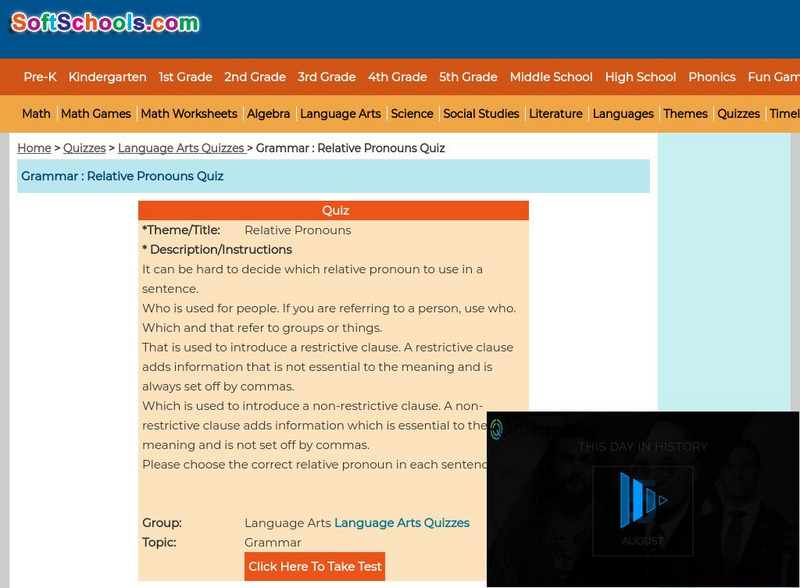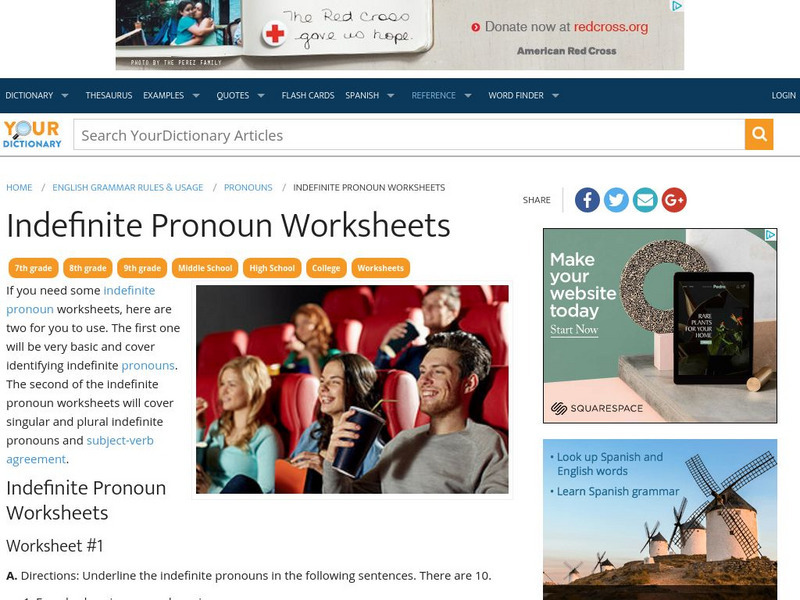Hi, what do you want to do?
Robin L. Simmons
Grammar Bytes: Subject Verb Agreement Power Point
Learn about subject-verb agreement and practice identifying correct agreement in questions that could be found on standardized tests.
Other
Project l.a.: What Are Pronouns?
An online slide show defines pronouns and explains their use at this site. A link at the end leads to an interactive quiz which provides immediate feedback and explanations for each answer.
Soft Schools
Soft Schools: Relative Pronouns
Learn about relative pronouns, then take a short quiz to check mastery.
E Reading Worksheets
E Reading Worksheets: Pronoun Worksheets
In this learning module, students will learn more about pronouns. Video lessons and reinforcement worksheets are provided. This module is designed to support Tier I, Tier II, and Tier III students in various grade bands.
Google
Google for Education: Indefinite Articles
Young scholars identify a pattern in the usage of the articles 'a' and 'an' and then write an algorithm that others can follow to correctly use these two indefinite pronouns, and they identify possible exceptions the general rule.
Grammarly
Grammarly Blog: Ending a Sentence With a Preposition
This page explains when it is acceptable to end a sentence with a preposition and when it is not.
Grammarly
Grammarly Blog: Everyone vs. Every One
This article provides the rules for the proper use of the words "everyone" and "every one" with examples.
Grammarly
Grammarly Blog: Adjective and Verb Placement
This page focuses on the relationships between adjectives and verbs including predicate adjectives, linking verbs, and participles --verbs used as adjectives such as the smiling baby.
University of Victoria (Canada)
Study Zone: Parts of Speech
Nice brief visual summary of the parts of speech - clear and concise - followed by an interactive practice quiz to reinforce concepts - great for ELL - has links to more in-depth explanations.
The Tongue Untied
The Tongue Untied: Nouns
Defines the many rules that govern the use of nouns, including their use as subjects, and the requirements for agreement; predicate nominatives; four types of objects (direct object, indirect object, object of preposition, and object of...
Arcademics
Arcademics: Giraffe Karts
Deterime which verb follows the subject verb agreement after the given word.
Goodwill
Gcf Global: I, Me, and Other Pronouns
Learn the proper use of I, me, and other pronouns. Includes a chart that tells you which pronouns can replace subjects and which can replace objects.
Capital Community College Foundation
Guide to Grammar and Writing: Its & It's & There, Their & They're Quiz
Ten sentences test your knowledge of when to use its or it's, there or their or "they're and the like. Click Submit to see answer key.
Quizlet
Quizlet: Point of View Practice for 3rd Grade Test
Point of view example sentences and associated pronouns in this review exercise. The following words are included: first person, second person, third person, I, me, mine, myself, we, us, ours, you, he, she, it, her, his, him, hers,...
BBC
Bbc: Skillswise: Verb Subject Agreement
How can you make sure you get the right verb form? Use this BBC Skillswise factsheet, worksheet, and quiz to learn more about subject-verb agreement.
Education Place
Houghton Mifflin: Eduplace: Noun and Pronoun Grammar Blast
Discover more about nouns and pronouns when you visit this "Grammar Blast," activity. Students have an opportunity to play a game while improving their grammar skills.
Grammarly
Grammarly Blog: Who and Whom
This page focuses on correctly using who or whom. Since who is a subjective pronoun, you can try replacing it with another subjective pronoun such as he or she to see how it sounds. Whom is an objective pronoun and can be replaced with...
Other
Verb Rules: Must and Have To
The verbs "must" and "have to" are often troublesome. This site gives instructions for their proper use.
Love To Know Media
Your Dictionary: Indefinite Pronoun Worksheets
Two worksheet provide plenty of experience for students to master indefinite pronouns and the way they interact with verbs.
Other
Ef Education First: English Grammar: Relative Adverbs
Information and examples about relative adverbs and how they are used to introduce relative clauses.
PBS
Pbs Learning Media: Make Sure Your Subjects and Verbs Agree
A verb is the action word of the sentence and it must agree with the subject, or main character, of the sentence. When the subject is singular, a verb needs an "s", but when the subject is plural, we can drop the "s". [0:41]
PBS
Pbs Learning Media: How to Use Intensive Pronouns
Intensive pronouns add needed emphasis to a sentence. While they function similarly to reflexive pronouns, they differ in that the pronoun can be removed without altering the meaning of the sentence. [0:57]
PBS
Pbs Learning Media: Reflexive Pronouns and Subjects
Reflexive pronouns reflect the subject of the sentence. A reflexive pronoun is a pronoun that is preceded or followed by the noun, adjective, adverb, or pronoun to which it refers within the same clause. [0:35]




















